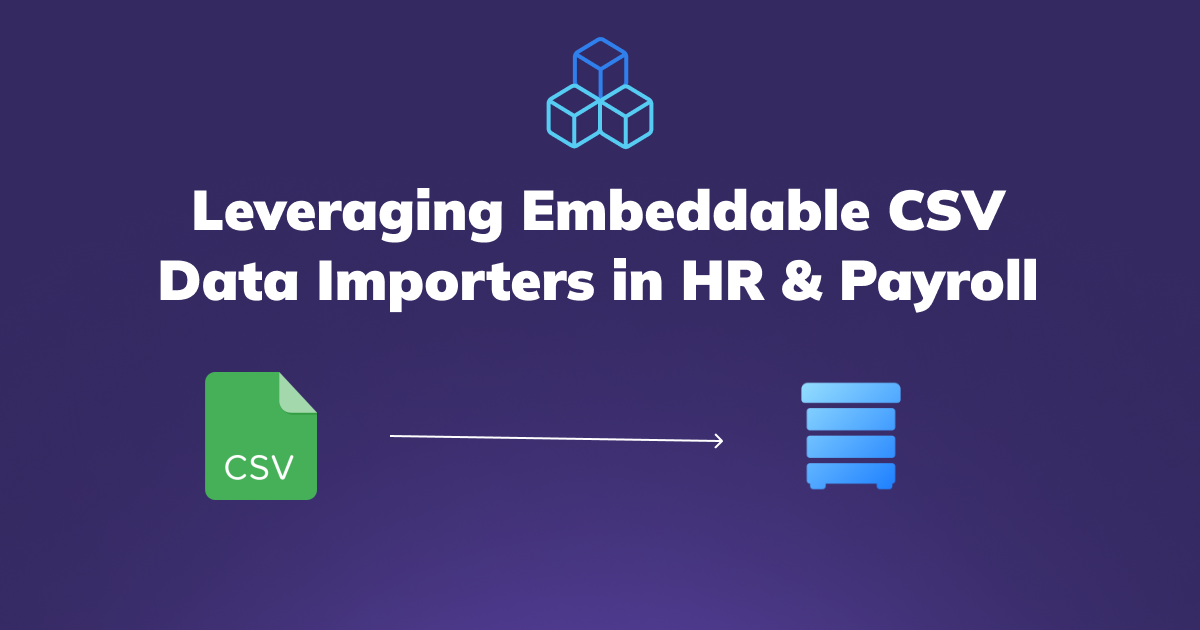Leveraging Embeddable CSV Data Importers in HR & Payroll

In today's hypercompetitive business environment, organizations continuously seek tools and processes that can streamline operations, reduce errors, and improve overall efficiency.
One such tool that has gained significant traction is the embeddable CSV data importer.
This blog post explores the various ways this tool can revolutionize the HR and payroll functions within an organization, emphasizing the benefits, use cases, and best practices involved.
What Is An Embeddable CSV Data Importer?
An embeddable CSV data importer is a software tool or component that can be integrated into various applications to enable users to upload and process data from CSV (Comma Separated Values) files seamlessly. While CSV files are one of the most common formats for exchanging information between disparate systems, integrating and managing this data can be challenging. An embeddable importer simplifies this process and enhances accuracy by handling data validation, mapping, and transformation automatically.
The Importance of Data Handling in HR & Payroll
Human Resources (HR) and payroll departments handle sensitive and extensive data daily—from employee personal details to salary information and performance metrics. Efficient handling of this data is paramount for ensuring compliance, maintaining operational efficiency, and enhancing employee satisfaction. Errors in data management can lead to severe repercussions, including legal issues, financial discrepancies, and decreased employee morale.
Integrating an embeddable CSV data importer into HR and payroll systems offers numerous advantages that traditional data handling methods simply can't compete with. Let's delve deeper into the key benefits and applications.
Key Benefits of Embeddable CSV Data Importers
- Enhanced Data Accuracy: Manual data entry is prone to errors. Even a small mistake in the HR or payroll data can lead to significant issues like incorrect pay calculations, which can further lead to employee dissatisfaction. Embeddable CSV data importers incorporate data validation rules that automatically check for errors, inconsistencies, and missing information, significantly reducing the likelihood of inaccuracies.
- Increased Efficiency: Manual data entry and data cleaning can be time-consuming tasks. An embeddable CSV data importer can automate these processes, allowing HR and payroll professionals to focus on more strategic activities. This increased efficiency fosters a more productive work environment.
- Time Savings: Time is a critical resource in every organization. Automating the import and validation of data not only saves time but also speeds up the entire HR and payroll process. This is particularly important during peak times such as payroll deadlines or end-of-year financial reviews.
- Compliance and Security: HR and payroll data are highly sensitive and subject to strict regulatory requirements. Embeddable CSV data importers come with built-in compliance checks and robust security features. They ensure that data handling aligns with legal requirements like GDPR, HIPAA, and other local regulations.
- Scalability: As organizations grow, the amount of data they handle also increases. Manually managing this data becomes increasingly impractical. Embeddable CSV data importers can easily scale to accommodate growing data needs, ensuring that the HR and payroll functions remain efficient and accurate regardless of organizational size.
Use Cases of Embeddable CSV Data Importers in HR & Payroll
- Employee Onboarding: Employee onboarding is a critical process that involves capturing a myriad of employee details, including personal information, bank details, qualifications, and more. An embeddable CSV data importer can simplify this process by enabling new hires to upload their data directly from CSV files, which are then automatically validated and populated into the HR system.
- Payroll Processing: Accurate payroll calculations require precise data on employee hours, salaries, tax details, and benefits. A CSV data importer ensures that all this information is imported correctly and consistently, reducing the risk of payroll errors. This is particularly important in organizations with a large workforce or those that operate in multiple regions with varying tax regulations.
- Performance Management; Performance reviews involve collecting and analyzing data from various sources. By using an embeddable CSV data importer, HR managers can easily consolidate performance metrics, training records, and employee feedback into a centralized system. This makes performance evaluations more objective, efficient, and transparent.
- Employee Self-Service Portals: Many organizations offer employee self-service portals where employees can upload and update their personal information. Integrating a CSV data importer into these portals allows employees to efficiently update their data, ensuring the HR records are always current without additional administrative burden.
- Compliance Reporting: Organizations need to regularly generate reports for compliance purposes. A CSV data importer can streamline this process by ensuring that the necessary data is accurately captured and readily available for reporting. This minimizes the risk of non-compliance and simplifies the auditing process.
Best Practices for Implementing Embeddable CSV Data Importers
- Choose the Right Tool: Selecting the right embeddable CSV data importer is crucial. Look for a tool that offers robust data validation, user-friendly interfaces, scalability, and strong security features. Compatibility with your existing HR and payroll systems is also essential for a seamless integration.
- Data Mapping and Transformation: Ensure that the importer you choose can handle data mapping and transformation. This involves mapping fields from the CSV file to the corresponding fields in your HR and payroll systems and transforming data formats as needed. Automating this process reduces errors and saves time.
- Data Validation Rules: Implement comprehensive data validation rules to catch errors and inconsistencies early. This can include checks for missing data, incorrect formats, duplicate entries, and more. The sooner errors are identified, the easier they are to correct.
- Secure Data Handling: Given the sensitive nature of HR and payroll data, security is paramount. Ensure that your CSV importer tool complies with relevant data protection regulations and incorporates strong encryption and access controls.
- User Training: Ensure that all users are adequately trained on how to use the CSV data importer. This training should cover how to format and upload CSV files correctly, interpret error messages, and take corrective actions. Well-informed users can significantly reduce the likelihood of errors and streamline the data import process.
- Continuous Monitoring and Improvement: Implement continuous monitoring mechanisms to track the performance of the CSV importer. Collect feedback from users and make necessary adjustments to improve functionality and user experience over time. This iterative approach ensures that the importer remains efficient and effective as organizational needs evolve.
Real-World Examples of CSV Data Importers in HR & Payroll
- Case Study 1: A Mid-Sized Firm Reducing Payroll Errors: A mid-sized manufacturing firm found that payroll errors were leading to dissatisfied employees and increased administrative workload. By integrating an embeddable CSV data importer, they were able to automate the import of clock-in/clock-out data, reducing manual entry errors. As a result, the accuracy of payroll calculations improved significantly, leading to enhanced employee satisfaction and lowered administrative costs.
- Case Study 2: Streamlined Onboarding at a Tech Startup: A fast-growing tech startup faced challenges in onboarding new employees quickly and accurately. The HR team decided to implement an embeddable CSV data importer. New hires could upload their information directly from their previous employers' exported files, which were then automatically validated and integrated into the HR system. This reduced onboarding time from several days to just a few hours.
- Case Study 3: Ensuring Compliance in a Multinational Corporation: A multinational company had to comply with different labor laws and standards across various regions. They integrated a CSV data importer that could handle data from different formats and apply region-specific validation rules. This ensured compliance with local regulations and streamlined the preparation of compliance reports.
Conclusion
Embeddable CSV data importers offer a powerful solution for managing HR and payroll data efficiently and accurately. By leveraging these tools, organizations can reduce errors, save time, ensure compliance, and enhance overall productivity.
The benefits and use cases discussed in this blog post underscore the transformative potential of embeddable CSV data importers in HR and payroll functions.
As data management becomes increasingly complex, relying on automated tools like CSV data importers will only become more critical. Organizations that adopt these tools will be better positioned to manage their HR and payroll functions effectively, providing a competitive edge in the ever-evolving business landscape. For those looking to stay ahead, the time to invest in embeddable CSV data importers is now. Let your HR and payroll departments step into the future of data handling with efficiency and accuracy.

